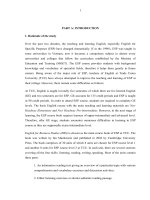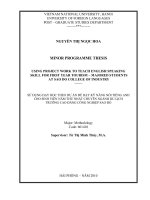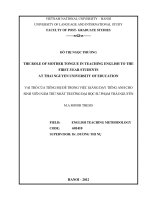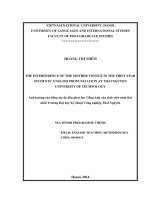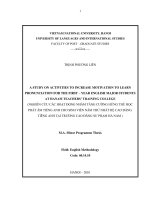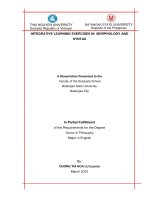ĐIỀU TRA THỰC TRẠNG DẠY VÀ HỌC TIẾNG ANH CHO SINH VIÊN NĂM THỨ NHẤT TRƯỜNG ĐẠI HỌC NÔNG LÂM – ĐẠI HỌC THÁI NGUYÊN
Bạn đang xem bản rút gọn của tài liệu. Xem và tải ngay bản đầy đủ của tài liệu tại đây (277.02 KB, 6 trang )
<span class='text_page_counter'>(1)</span><div class='page_container' data-page=1>
<b>AN INVESTIGATION INTO THE REALITY OF TEACHING </b>
<b>AND LEARNING ENGLISH FOR THE FIRST YEAR STUDENTS </b>
<b>AT THAI NGUYEN UNIVERSITY OF AGRICULTURE AND FORESTRY </b>
<b> Van Thi Quynh Hoa*, Nguyen Quynh Duong </b>
<i>University of Agriculture and Forestry - TNU </i>
ABSTRACT
This study attempted to investigate how English is taught and learnt for the first year students in
Thai Nguyen University of Agriculture and Forestry (TUAF) including the teachers’ professional
knowledge, the conditions of teaching and learning English, opportunities for students to use
English outside classroom, opportunities for teachers' professional development, and to offer some
suggestions for improving teaching and learning English in TUAF. The subjects of this study were
200 students and 6 teachers at TUAF. To achieve the aims of the study, a quantitative
questionnaire was used to collect the needed data. The findings show that majority of the teachers
have quite good theoretical professional knowledge. Teaching condition is quite good. Some
students express their positive attitudes to English learning, but they had too little exposure to
English language outside classroom.
<i><b>Keywords: teaching and learning English, first year students, Thai Nguyen University of </b></i>
<i>Agriculture and Forestry. </i>
INTRODUCTION *
In the education sector, despite the presence
of other popular foreign languages in Vietnam
today, English is considered the most
important foreign language in colleges and
universities (Nguyen, 2002).
Teaching and learning are the two mains
processes in any classroom practice, theories
and approaches all seem to support the ideas
of making use of technology to increase the
effectiveness of teaching (Le Thao & Le
Quynh,2012) and empowering students in
their learning process. However, we may have
all known that every teaching situation is
different and every language learning process
in the classroom is different. Moreover, there
is always a big gap between language
teaching and learning students do not always
learn everything they are taught.
There is also a popular claim among
researchers and employers about the weak
English skills of the majority university
students (Nunan,2003; Tran Ngoc Ca, 2006).
In order to study English as a foreign
language and be successful at it, the students
*
<i>Tel: 0982 068949; Email: </i>
must be helped by the teacher to acquire skills
in the four language art skills, namely:
speaking, listening, writing, and reading. This
study was aimed to find out the English
teaching and learning facts in TUAF. Also, it
is expected that this study will be referred to
as evidence to the necessity in improving
those facts.
SUBJECT AND METHODOLOGY
Participants in this study were 200 students
and 6 teachers at TUAF. They were selected
at random to participate in this study. The
activities carried out were according to the
course syllabus of Basic English I, II. To
achieve the aims of the study, a quantitative
questionnaire was used to collect the
needed data.
FINDINGS, RESULTS AND DISCUSSION
<b>Students’ questionnaire </b>
<i><b>Students’ attitudes and motivation to learn English </b></i>
</div>
<span class='text_page_counter'>(2)</span><div class='page_container' data-page=2>
<i><b>Table 1: Students’ reasons for learning English. </b></i>
<i>(N= 200) </i>
<b>Reasons for learning </b>
<b>English </b>
<b>Number of </b>
<b>respondents (%) </b>
Interests in English 15
Communicate in English 14
Need for future career 20
Pass the exams 18
A compulsory subject 31
Others 0
The result from Table 1 showed that many
students in TUAF for gifted students were
aware of benefits of learning English.
However, the portion of 19.5% of students
said they learned English to pass the exam
and 31% said it was a compulsory subject
revealed that a greater number of students
were not really motivated in learning English.
Moreover, in regard to the importance of
getting good mark in class (Q3), it is
interesting to find out that more than half of
the respondents (51%) revealed that good
mark was their goal in learning English. The
results of the responses are presented in the
table 2 below:
<i><b>Table 2: Students’ responses to the importance of </b></i>
<i>good marks in class (N=200) </i>
<b>The importance of </b>
<b>good marks </b>
<b>Agree (%) </b>
Very important 51%
Just to have a pass mark 24%
Don’t care 25%
Participants’ attitudes to English language
learning are the aims of the next two
questions. Many of them revealed that they
found the English lessons necessary (29%)
and interesting (18%). However, the number
of students who have negative attitude
towards learning English raised a
considerable concern. Some of them revealed
that the English lessons were boring (16%)
and time wasting (1.5%). In addition to that,
many of the participants (26%) said that the
lessons were difficult for them. 2.5% of them
said that the lessons were remote from their
real life and 6% have no idea. (See table 3).
<i><b>Table 3: Students’ attitudes towards English lessons </b></i>
<b>Attitudes to English </b>
<b>lessons </b>
<b>Number of </b>
<b>respondents (%) </b>
Boring 16
Waste of time 1.5
Necessary 29
Interesting 18
Difficult 26
Easy 1
Unrealistic 2.5
No idea 6
<i><b>Students’ access to resources </b></i>
The next four questions (Q4, Q5, Q6, Q7)
attempt to find out to which extend other
materials are used by students and teachers
beside textbooks to improve their language
learning. Table 4 is the summary of the results
of responses to the questions with students:
<i><b>Table 4: Students’ access to resources (N=200) </b></i>
<b>How often </b> <b>Usually % </b> <b>Sometimes </b>
<b>% </b> <b>Rarely % </b>
<b>Never </b>
<b>% </b>
Do you read books or newspapers in English? 0.8 17 34 48
Do your teachers of English use a tape
recorder to teach you listening? 0 6 15 79
Do you learn English in a language laboratory? 0 0 0 0
79% of respondents said that the teachers had never used tape recorder to teach them English in
class and 100% commented that they had never had an English lesson in the language laboratory.
The findings indicated that teaching listening was not regarded as an important part in teaching
English. Furthermore, 34% of students rarely read books and newspapers in English and 48%
never, confirmed that the students learned English in a very simple way.
</div>
<span class='text_page_counter'>(3)</span><div class='page_container' data-page=3>
they never used any materials except the
textbooks. It can be seen that they mainly
focused on developing their reading skill and
grammar exercises. This correlates with the
reasons they chose to learn English-to pass
the exams.
<i><b>Opportunities to use English outside </b></i>
<i><b>classroom </b></i>
The results showed that students had too little
exposure to the language they learned outside
their class. 46% of the students revealed that
they rarely had opportunities to speak English to
English speaking people and 38% said never.
Only 2% said they usually spoke English to
English speaking people (see table 6).
<i><b>Table 5: Summary of responses to students’ </b></i>
<i>material using. N=200 </i>
<b>Learning resources used </b> <b>Number of </b>
<b>respondents (%) </b>
Workbooks 50
Grammar and reference
books
54
Newspapers and
magazines
6
The Internet 22
Others:- Nothing 7
<i><b>Table 6: Students’ opportunities to speak English to English speaking people. N=200 </b></i>
<b>Number of </b>
<b>respondents </b>
<b>Usually </b>
<b>% </b>
<b>Sometimes </b>
<b>% </b>
<b>Rarely </b>
<b>% </b>
<b>Never </b>
<b>% </b>
200 2 14 46 38
<b>Teachers’ questionnaire </b>
<i><b>Teachers’ professional knowledge </b></i>
The first 12 questions in the questionnaire were designed to measure the teachers’ professional
knowledge. Question 1 and 2 attempt to find out the aim of teaching English as identified by the
teachers of the university. The results of the question 1 are presented in the table below:
<i><b>Table 7: Teachers’ views on the aims of teaching English. N=6 </b></i>
<b>The aims of teaching English is to enable the students to </b> <b>Number of respondents % </b>
Have simple conversation in English with other English speaking people 50
Read simple texts in English 83
Write personal letter to friends 50
Study in English speaking country 33
Understand English grammar and do grammar exercises 83
Acquire a certain amount of vocabulary 83
Do well in exams 16
Understand more about English 16
Findings from question 2 confirm the discussion above. Table 8 presents the results of this
question.
<i><b>Table 8: Teachers’ opinion about the aspect of language taught at TUAF </b></i>
<b>Aspects of language </b> <b>T 1 </b> <b>T2 </b> <b>T3 </b> <b>T4 </b> <b>T5 </b> <b>T6 </b> <b>Total </b>
Grammar 3 3 4 3 1 1 15
Vocabulary 2 2 5 4 3 2 18
Pronunciation 1 1 6 7 4 3 22
Writing 8 7 7 5 8 7 42
Listening 4 8 8 6 7 8 41
Extensive reading 6 5 2 8 5 6 32
Intensive reading 5 4 3 2 6 5 25
Conversational skill 7 6 1 1 2 4 21
</div>
<span class='text_page_counter'>(4)</span><div class='page_container' data-page=4>
<i><b>Table 9: Teachers’ beliefs in teaching and learning. N=6 </b></i>
<b>Beliefs </b> <b>Strongly agree </b>
<b>% </b>
<b>Agree </b>
<b>% </b>
<b>Disagree </b>
<b>% </b>
<b>Strongly </b>
<b>disagree % </b>
Grammar is a worthwhile component for
any language curriculum? 17 66 17 0
Listening, speaking, writing and reading
skills should be taught separately? 33 17 33 17
Students always learn more from their
teachers than they learn by themselves? 0 83 17 0
Learners should not be allowed to make
errors and any errors have to be corrected
immediately?
0 17 66 17
It is important to repeat and practice a lot in
learning a foreign language? 66 34 0 0
<i><b>Table 10: Teachers’ awareness about the important of factors affecting language learning </b></i>
<b>Factors affecting language </b>
<b>learning </b>
<b>Very </b>
<b>important % </b>
<b>Important </b>
<b>% </b>
<b>Not very </b>
<b>important % </b>
<b>Not very </b>
<b>important at all </b>
Intelligence 17 67 17 0
Aptitude 50 50 0 0
Personality 17 67 0 17
Motivation 33 67 0 0
Learning strategies 67 0 33 0
Learner belief 67 17 0 17
Age 0 17 67 17
Question 5 attempts to find out teachers’
opinion on how to teach listening, speaking,
reading and writing skills. The findings show
that they have quite different perception about
this problem. 2 participants out of 6 strongly
agreed that these skills should be taught
separately, one selected “agree” while other
two disagreed and one strongly disagreed.
This revealed 50% of the participants did not
realize the necessity of integrating skills in
language teaching.
The results from question 6 showed that 83%
of the respondents agreed that students always
learned more from their teachers than by
themselves. Only one chose “disagreed”.
Obviously, students cannot learn the language
if they are not taught.
Question 7 referred the teachers’ evaluation
of students’ mistakes. 4 participants out of 6
said that they disagreed, one said strongly
disagreed, only one agreed that learners
should not be allowed to make mistakes and
any mistakes has to be corrected immediately.
Thus, mistakes correction has to be varied
according to the specific characteristics of the
students.
In regard to the role of practice in learning a
language, 67% of the participants strongly
agreed that it is important to repeat and
practice a lot in learning a foreign language
and 33% said they disagreed. The participants
revealed that practice plays a very important
role in their teaching.
The 10 question is intended to find out which
factor among “the teacher”, “the learners” and
“the teaching material play the most
important role in the classroom. The results
showed that most of the participants (67%)
are learner-centered which is in favor
language teaching methodology now. A small
percentage (33%) said that the teacher is the
most decisive factor in the classroom.
</div>
<span class='text_page_counter'>(5)</span><div class='page_container' data-page=5>
the result of question 11 indicated that most
of the respondents revealed that they saw the
important role of the following factors as
showed in the table 10.
In order to find out which classroom
techniques could help the teachers most to
bring about effective teaching, question 12
was included in the questionnaire. The
techniques chosen by most of the respondents
were using blackboard and organizing group
work and pair work (100%).
Materials are closely related to teachers and
learners. They play a very important role in
teaching and learning. As the results of the
question 13 showed, 33 % of the respondents
said that they were not satisfied with the
textbooks. 100% of the participants revealed
that they used other materials beside the
textbooks in their teaching. It is obvious that
the respondents had tried quite hard to make
the lessons more interesting and effective
using different sources of materials.
Question 16 attempts to find out the way the
participant use the textbooks they are
teaching. 50% of the participants said that
they designed new exercises, 17% simplified
the exercises or activities if necessary. It
showed that the teachers in TUAF have been
aware of the necessity of adapting textbooks
in their teaching. However, there is a
percentage of 33% just taught everything in
the textbooks.
<i><b>Opportunities for teachers’ professional </b></i>
<i><b>development </b></i>
The results of question 18 showed that the
respondents mainly shared their teaching
experience with their colleagues. Using the
Internet is another way which was used by most
of the respondents to improve their teaching.
Question 19 attempted to find out if the
respondents had opportunities to take part in
workshops on language teaching
methodology. 5 teachers out of 6 said that
they had participated in workshops.
The last question is an open question. It
attempted to find out the respondents’ ideas
about the effectiveness of the workshops. 3 of
them said that the workshops were quite
effective. 2 of them had no idea about the
workshops. Clearly, the respondents revealed
the effectiveness of the workshops but it
would be better if they lasted longer and were
organized more frequently.
CONCLUSIONS AND RECOMMENDATIONS
<b>Conclusions </b>
The teachers were carefully selected and they
have high qualifications. Therefore, majority
of them have quite good theoretical
professional knowledge.
Teaching condition is quite good, the university
has a language laboratory, with cassettes, many
computers, and a library with different
supplementary materials. Most of them have
participated in conferences or workshops on
language teaching methodology.
Some students express their positive attitudes
to English learning. In general, they are not
quite satisfied with the lessons provided by
the teachers, especially the topics, and the
techniques to motivate them in learning. The
students had too little exposure to English
language outside classroom.
<b>Recommendations </b>
The important implication for the teacher is to
vary their techniques and activities so as to
involve more students in the lesson and to
reduce the boredom of the lesson. The
learning environment also plays an important
part. Besides, the teacher’s behavior is a
decisive factor to increase students’
motivation.
</div>
<span class='text_page_counter'>(6)</span><div class='page_container' data-page=6>
interesting to learners. Various and relevant
kinds of exercises should be added.
In order to help teachers do an effective job of
teaching, conducting effective professional
development activities is really crucial. It is
highly recommended that authorities and
policy makers should give a special priority to
help the teachers in mountainous areas so that
they can participate informal language
teaching training courses to have
opportunities to develop their professional
growth and advancement.
REFERENCES
<i>1. Le Thao, & Le Quynh. (2012). Technologies for </i>
<i>Enhancing </i> <i>Pedagogy, </i> <i>Engagement </i> <i>and </i>
<i>Empowerment in Education. Pennsylvania: IGI </i>
Global.
<i>2. Nguyen, A. T. H. (2002). Cultural effects on </i>
<i>learning and teaching English in Vietnam. The </i>
Language Teacher Online.
<i>3. Nunan, D. (2003). The Impact of English as a </i>
<i>Global Language on Educational Policies and </i>
<i>Practices in the Asia-Pacific Region. Tesol </i>
Quarterly, 37(4),589-613.
<i>4. Tran Ngoc Ca.(2006). Universities as Drivers of </i>
<i>the Urban Economies in Asia: the Case of Vietnam. </i>
Policy Research Working Paper: World Bank
TÓM TẮT
<b>ĐIỀU TRA THỰC TRẠNG DẠY VÀ HỌC TIẾNG ANH </b>
<b>CHO SINH VIÊN NĂM THỨ NHẤT TRƯỜNG ĐẠI HỌC NÔNG LÂM – </b>
<b>ĐẠI HỌC THÁI NGUYÊN </b>
<b>Văn Thị Quỳnh Hoa*<sub>, Nguyễn Quỳnh Dương </sub></b>
<i>Trường Đại học Nông Lâm – ĐH Thái Nguyên </i>
Nghiên cứu này điều tra việc dạy và học tiếng Anh cho sinh viên năm thứ nhất tại trường Đai học
Nông Lâm Thái Nguyên bao gồm kiến thức chuyên môn của giáo viên và phương pháp giảng dạy,
các điều kiện dạy và học tiếng Anh, cơ hội sử dụng tiếng Anh ngoài lớp học của sinh viên, cơ hội
phát triển chuyên môn của giáo viên, và một số gợi ý để nâng cao việc dạy và học tiếng Anh cho
sinh viên. Đối tượng của nghiên cứu này là 200 sinh viên và 6 giáo viên. Để đạt được mục tiêu của
nghiên cứu này, một bảng câu hỏi định lượng được sử dụng để thu thập các dữ liệu cần thiết. Kết
quả cho thấy đa số giáo viên có kiến thức chun mơn tốt, điều kiện giảng dạy tốt, một số sinh
viên bày tỏ thái độ tích cực trong việc học tiếng Anh và sinh viên có ít cơ hội sử dụng tiếng Anh
ngoại khóa.
<i><b>Từ khóa: học và dạy tiếng Anh, sinh viên năm thứ nhất, trường Đại học Nông Lâm Thái Nguyên </b></i>
<i><b>Ngày nhận bài: 26/8/2016; Ngày phản biện: 13/9/2016; Ngày duyệt đăng: 31/03/2017</b></i>
*
</div>
<!--links-->

